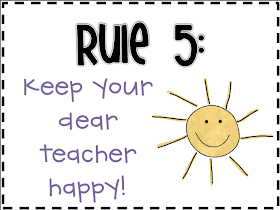My second year teaching Spanish has already been exponentially better than my first. For one, the students know me better so there is slightly less limit testing than last year. Second, we switched from 55 minutes once every six days to 25 minutes twice every six days. The shorter time is easier for them to take in an immersion style class.
And just as importantly I adopted a new classroom management system - Whole Brain Teaching. I wholly suggest visiting the website
wholebrainteaching.com and watching some videos on youtube. It works better if you adopt it ALL rather than just parts. Up first is a video that I found this summer that really inspired me to give Whole Brain Teaching a try. Below is a summary of the signals and routines that we use in my classes and how I introduced them to my students.
Quiet signal - I say "
clase, clase" and the students respond with "
sí, sí." Then they get so quiet that if someone walked in they would think we were all sleeping. (Yes, I say exactly that when I explain it to the kids.) They have to say
sí, sí however I say
clase, clase. So if I draw it out really long with a dip at the end then they should too. If I whisper then they should whisper it. I usually play around with the signal to keep their attention. Sometimes I sing it. Sometimes I say it three times instead of twice or once really short. It keeps them on their toes.
Hands, hands and eyes - This is the signal when I really want their attention. I don't use it as often as I should based on the advice from wholebrainteaching.com. I tend to use it to give instructions to a game or clean up at the end of class. I say "
manos manos ojos" and the students repeat it back putting their hands together and staring at me like I have a big cheeseburger on my forehead (this is particularly effective for the second and third graders who have me just before lunch.)
Mirror - On the Whole Brain Teaching website they suggest "chunking" material and having students repeat after you with gestures. The gestures help those kinesthetic learners and prepares my novice speakers to augment their communication using gestures. I say "
espejo" and the students say "
espejo OK." I have pictures with the words in Spanish on the SMART board in my prezi presentation and the kids repeat after me with the gesture. That way they see, hear, and act out each word or phrase. I teach one word or phrase at a time and work up. I don't exceed 10. Once I've taught the new vocab/phrases we insert them into games, read them in authentic resources, and use them in simulations. I do usually review them briefly using Espejo at the beginning of each class so as to bring students back into what we are doing since I sometimes go several days between seeing them.
Teach - After mirroring me students need to teach and practice with their classmates to help solidify the new information in their brains. I say "
enseña" and the students say "
enseña OK." Then they turn to each other and practice the information we just practiced in the mirror phase. With conversations, one student asks the question and the other student answers.
Switch - To make sure that everyone gets a turn to teach we switch halfway through. Students who were teaching now listen and students who were listening now teach. OR, if we are doing a question and answer then one student asks and the other student answers and then they switch roles. I say "
cambia" and the students say "
cambia OK."
Now here's the important part - we practiced and practiced and practiced at the beginning of the year. Some classes we still sometimes stop class and practice some more. Some people claim that they can start class in 90% TL right from day one. I am NOT one of those people. I wanted my students to know exactly how my routines would work. We learned the signals by going over and over and over the rules. I
mirrored them with gestures. They taught them to each other. Then they
switched. I got them quiet using the quiet signal. We practiced manos, manos ojos. UNTIL THEY GOT IT. I didn't start teaching content or speaking mostly in Spanish until the third rotation or I was sure that the class knew the routines. Now that they know them I speak much more Spanish in class than I ever did before!
And speaking of rules, that's part two of my series on Whole Brain Teaching.
See
Part Two - The Rules and
Part Three - The Scoreboard.











